In 1219, a little over 800 years to the day, Sir William Marshal passed away at the goodly age of around 73. A military man for much of his life, living to this ripe old age was an achievement in times where the average life expectancy was around 35 to 40!
- The Greatest Knight
- The Marshal Family
- Survival of the Fittest
- A Young Knight
- Scandal and Slander
- Fortune Favours the Brave
- A Lasting Legacy
He was so beloved by his family that just after his death his son commissioned the Histoire de Guillaume le Maréchal (History of William Marshal). The earliest surviving biography of a medieval knight.
The Greatest Knight
This extensive and biographical poem was written by an unknown author shortly after Marshal’s death. It gives us a valuable account of the turbulent times in which he lived, survived, thrived, and ultimately served four English kings.
Read More: Medieval Sword Found in Poland
Given that the biography was produced for the family, it is a favourably biased account of his life no doubt. However, William Marshal’s rise from relatively humble beginnings does suggest that he was possessed of some unique qualities.
Today, he has come to represent the epitome of the chivalric knight: loyal, heroic, skilled in battle and gracious.
The Marshal Family
William may not have lived to become the famed knight he was, were he not spared from being catapulted over the walls of his father’s castle at the tender age of 4 or 5 years old!
Read More: Unearthed Rare 1000 Year-Old Viking Arrowhead
William Marshal was the 2nd son of the union between John Fitz Gilbert, Marshal and keeper of the king’s horses and his second wife Sybil. Fitz Gilbert was a middle-ranking noble with holdings in southwest England.
After the death of William the Conqueror’s youngest son, King Henry I, there were two claimants to the throne of England. Stephen of Blois (eldest son of William the Conqueror’s daughter Adela) and Mathilda, daughter of Henry I.
A civil war erupted and William’s father, John swore allegiance to King Stephen. Later, he was to change sides and fight for Mathilda’s right to rule.
This incurred the wrath of King Stephen who besieged John at his castle of Newbury in 1152. (There is no firm record of this castle ever having existed at Newbury beyond the account given in Marshal’s biography. It is now believed to be a Motte and Bailey type castle located at nearby, Hamsted Marshall, a village on the North Wessex Downs.)
Adored
The story goes that John Marshal requested a cessation in the fighting in order to parley with Empress Mathilda. This request was granted on the proviso that John leave behind a suitable hostage. And this is where a young William Marshal enters the story!
Read More: Moaning about Unfair Pay in the Roman Army
William’s father refused to surrender and so King Stephen declared that he would either hang the child or launch him towards the castle walls in a catapult device. John Marshal reportedly retorted that he had a good enough hammer and anvils to make more and better sons than William!
Stephen, not expecting this Casanova-style response given the gravity of the threat, was ultimately moved to mercy having grown fond of the young boy.
This story was recounted by William himself throughout his life before it was recorded in his biography.
Survival of the Fittest
As a younger son, William knew he was unlikely to inherit. At this time the general rule was that the first son inherits (primogeniture) while the second will train as a knight or fighting man.
The idea behind this being that should the eldest die, the second would be a suitable and prepared alternative. A third son would likely be expected to join the church.
His Training Begins
In William’s case, though he was John’s fourth son, he was the second son in his father’s second marriage. Therefore, according to the practices of the day he was fostered by another landed family to learn the ways of the knight.
Read More: Found: 1,600 Year Old Sword That Belonged to a Roman Soldier
Around the age of 13 William was dispatched to the home of William de Tancarville, a great Lord in Normandy. The region was held by the English crown. During his time in Normandy, William would have been trained as a squire before encompassing all aspects of knighthood.
He was reportedly a good student, strong, savvy and capable. However, he had an insatiable appetite for food and earned himself some rather unfavourable nicknames in the process!
Food Glorious Food
However, he was a growing lad, and grow he did! Eventually standing at around 6ft where the average height was around 5ft 8” or 173cm.
During his time in Normandy his father and eldest brother (from his father’s first marriage) had both passed away. William’s older brother also called John now inherited.
Meanwhile, William was knighted at the age 20 years old at Driencourt. This was literally just before a battle was to be fought between King Henry II and King Louis VII of France. He was to have his skills put to the test immediately.
A Young Knight
William supposedly fought well, but failed to capture any knights for ransom and lost his horse in a skirmish! He was to learn a hard lesson here that battle was not only for glory but for profit. This was essential for a young knight whose father had died leaving him nothing.
Read More: 800 Year old Complete Chain Mail Vest Discovered
Effectively penniless with neither land, nor property of his own and now not even a horse, William needed some help. Whether William de Tancarville felt magnanimous in his recent victory, and gifted William the last horse in his stables or whether William had to sell the clothes he stood up in to buy one – we don’t know.
He was however, able to accompany the retinue on the tourney circuit in northern France. By the end of the melee (a mock battle with the aim of capturing opposition knights for ransom), William had distinguished himself and certainly made an impression, leaving the field having won 4 horses!
The Legend Begins
The joust was partly for entertainment and partly battle practice. It was also an unrivalled opportunity for a talented young knight such as William to make a name for himself.
He competed and toured, competed and won. He attended many tournaments over the years and became wealthy in his own right as a result. William himself estimated he had ransomed over 500 knights by the end of his career.
A Knight’s Tale
There were some stories of embarrassing setbacks. Once he took so many blows to the head his helmet required the assistance of a blacksmith to be removed. This story is the likely origin of a similarly comedic scene presented in the movie A Knight’s Tale starring the late Heath Ledger.
Read More: The English Longbow of Legend
By 1168 William again was called to fight. This time in real warfare at Poitou.
Here he was both injured and captured by the forces of Guy de Lusignan. But thanks to the practice of ransoming hostages he was freed for a price!
His heroic rescuer in this instance was none other than Eleanor of Aquitaine, Queen consort to King Henry II. Eleanor hired him as tutor-in-arms to her son, the young King Henry who was then aged just 15 and had already been crowned by his father.
Scandal and Slander
William became ever wealthier through competing on the tourney circuit as the head of young King Henry’s tourney team. Then, aged in his mid-30s a scandalous disaster struck!
Read More: Found: 1,600 Year Old Sword That Belonged to a Roman Soldier
William was accused of conducting an affair with the young king’s wife, Margaret of France. A transgression which saw him barred from court.
William’s contemporaries suggest that this affair never actually took place. Instead suggesting it was either jealous gossip spread by his enemies at court or instead a convenient means for young King Henry to commence the annulment process on discovering Margaret to be barren.
Five years previously Margaret had given birth to a baby boy prematurely. The infant, William, passed away just 3 days later. She was to have no further children.
William Marshal returned to court just one year later and was reconciled with young King Henry. Henry was never to reign however. He died of dysentery in 1183 after swearing an oath to go on a religious crusade and recapture Jerusalem from the Arabs.
The Crusades
It has been said that Henry made William promise to take up the crusade in his stead while he lay on his deathbed aged just 28 years old.
After the death of King Henry II just three years later it was the turn of another of his sons and arguably one of the most famous, Richard the Lionheart.
Read More: Roman Battlefield Medics, a Brutal Job
Richard was born and grew up in England but spent most of his adult life in Aquitaine (south-west France) or on Crusade. Richard and his brothers had some conflict with their father the king and it was during a skirmish in France that William and Richard first clashed.
William bested Richard during the fight and supposedly unhorsed him before ramming the point home by slaying Richard’s horse.
Once his father had died, you might think that Richard, now the new King of England might take the opportunity to exact revenge on his father’s man. Instead, the opposite happened.
Fortune Favours the Brave
The newly crowned King Richard gave William, now aged 43 the hand in marriage of young heiress Isabel de Clare and with her a substantial amount of land across England, Ireland, Normandy and Wales. Isabel was just 17 at this time but by marriage she had transformed William into one of the richest landowners in the country.
William co-governed England and defended Richard’s lands in France whilst Richard was away on the Third Crusade in 1190. Indeed, even seven years later, a 50-year-old William Marshal apparently scaled the walls of a French castle at the centre of a rebellion and seized it successfully whilst awaiting reinforcements.
Richard the Lionheart
Richard had a very awkward return home and while back in France, defending his lands yet again, his days were numbered. Wounded by a crossbow bolt fired by a young crossbowman said to be little more than a boy, King Richard the Lionheart died from the gangrenous wound.
With the death of Richard came the ascension of his younger brother, John. A character whom history paints in a very different light.
Yet, William served John as faithfully as he had his brothers and father, supporting him politically amidst regular uprisings in the north of England. He mediated between the feuding parties until the issuing of the Magna Carta in 1215 which bought peace for a short time.
Read More: 800 Year old Complete Chain Mail Vest Discovered
In 1216 when King John died from dysentery William was made regent and protector of the new king, nine-year-old Henry III. William himself re-issued versions of the Magna Carta in 1216 and again in 1217 in an effort to keep peace in the realm of the young monarch.
But peace is a tenuous concept in such turbulent times and before long there would be more skirmishes and battles to be fought.
A Lasting Legacy
Amazingly, though William had now reached the age of 70 he could still be found fighting at the head of the king’s army. He led the charge to successfully fight off a French invasion supported by rebellious northern English barons at the Battle of Lincoln in 1217!
It was two years later in 1219 that William’s age finally caught up with him. Realising that he was soon to die he summoned all the country’s leading powers to his bedside.
Read More: Discovered the Remains of Medieval Soldier
There he arranged a fitting replacement to act as regent for the young king. Loyal to the end and wishing to ensure England was left in good hands (as he saw it) after his death.
Read More: The Semi Derelict Medieval Town of Buje
In a final act, William Marshal was invested into the Order of the Knights Templar on his deathbed. His last words were recorded to be, “I cannot defend myself from death.”
Knights Templar
And so, the great lord that was William Marshal passed away. Leaving his wife, Isabel and their ten children to continue his legacy. Each of his sons one by one inherited the Earldom of Pembroke and the title Marshal of England.
However, none of them produced any legitimate surviving heirs. William’s lands and holdings were therefore divided between his son-in-laws.
Rather remarkably, William Marshal is ancestor to both the Bruce and Stewart kings of Scotland. He is also an ancestor of the last Plantagenet kings, Edward IV and Richard III and all English monarchs from Henry VII onwards.
William Marshal is remembered by these deeds as recorded in his biographical history. However, history speaks for itself. Through his recorded actions we can determine for ourselves what kind of man he might have been.
Read More: Medieval Sword Found in Poland
A talented tactician, unswervingly loyal to the kings of England, a skilled fighter and later a trusted politician. Upon reflection of his acts throughout his life, which number many more than the snapshot explored here, it is understandable that he earned the epitaph , “the greatest knight to have ever lived.’’







Your common sense should be accepted and normal for all.
Much respect for blogging this subject. Do you intend to expand your ideas?
Thanks for being so informative. illplaywithyou
It’s actually a nice and useful piece of info.
I am happy that you shared this helpful information with
us. Please keep us up to date like this. Thanks for sharing.
My blog post :: vpn code 2024
I read this post fully about the difference of most recent and earlier technologies, it’s remarkable article.
Here is my website :: vpn coupon code 2024
I’m eagerly awaiting your next piece. hot nude cams
I always leave your blog feeling inspired. Adult Webcams
Làm tốt khi tạo vật liệu xuất sắc như vậy! Mong chờ nhiều hơn từ bạn!
Nhanh chóng đăng ký và nhận ngay thưởng đăng ký tại yo88.com! Trải nghiệm ngay!
Đừng bỏ lỡ cơ hội đăng ký ngay và được nhận những phần thưởng hấp dẫn tại yo88 .com!
I just could not leave your website prior to suggesting that I actually loved the standard info a person provide for your guests?
Is gonna be back steadily in order facebook vs eharmony to find love online investigate cross-check new
posts